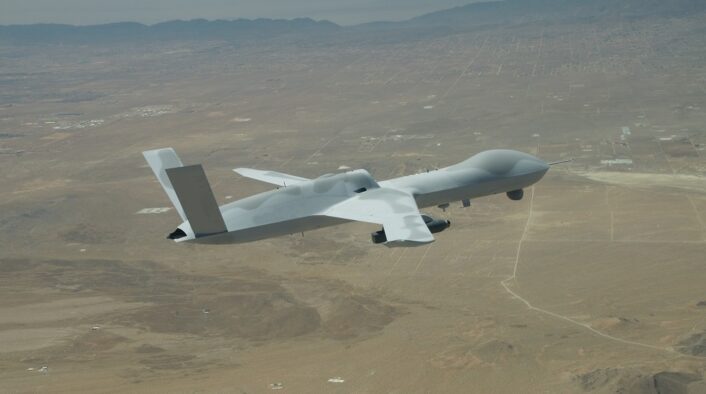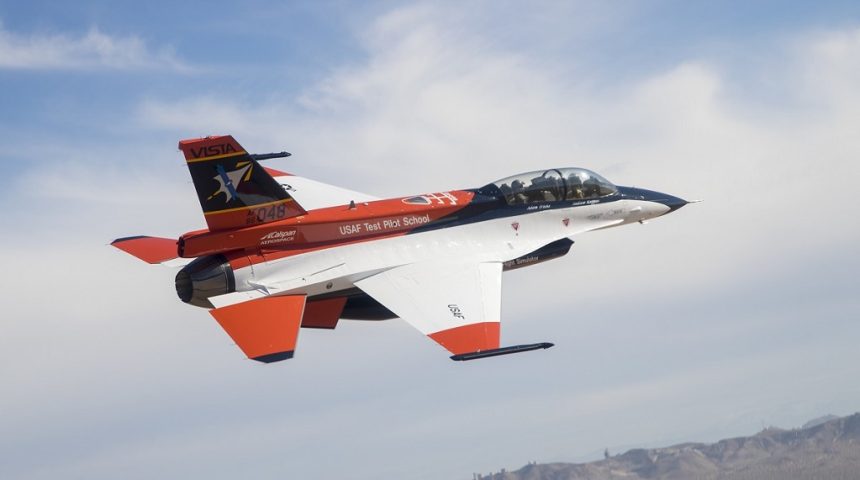The NF-16D VISTA aircraft is currently being upgraded to remove some limitations and better support autonomy testing for the Air Force Research Laboratory’s Skyborg program.
The NF-16D VISTA (Variable In-flight Simulator Aircraft), operated by the U.S. Air Force Test Pilot School at Edwards Air Force Base (California), has been redesignated as the X-62A from June 14, 2021 in preparation for its participation in Skyborg autonomous flight tests with the Air Force Research Laboratory (AFRL).
The NF-16 VISTA started life as a F-16D Block 30 which later received numerous upgrades and modifications, flying for the first time in the new configuration in 1992, and became an important part of the Test Pilot School curriculum. A distinctive modification of this aircraft is the central control stick connected to the simulation system, in addition to the F-16’s peculiar side stick. The aircraft’s VISTA Simulation System (VSS) provided TPS students the ability to experience various flying conditions including simulation of other aircrafts’ characteristics.
“For more than two decades VISTA has been a vital asset for the USAF TPS and the embodiment of our goal to be part of the cutting edge of flight test and aerospace technology,” said William Gray, VISTA and TPS chief test pilot. “It has given almost a thousand students and staff members the opportunity to practice testing aircraft with dangerously poor flying qualities, and to execute risk-reduction flight test programs for advanced technologies.”
The NF-16 VISTA is currently being upgraded to fully replace the VSS and add a new system called the System for Autonomous Control of Simulation (SACS) to support autonomy testing for the Air Force Research Laboratory’s Skyborg program, prompting the redesignation as an X-plane. “The redesignation reflects the research done on the aircraft over the past almost 30 years, as well as acknowledges the major upgrade program that is ongoing to support future USAF autonomy testing,” said Dr. Chris Cotting, USAF TPS director of research.
Previously, the NF-16D VISTA only had the N prefix to denote its status as Special Test, Permanent, indicating that the aircraft configuration is so drastically changed that a return to its original configuration is beyond practicable or economic limits. The new X designation denotes that now the aircraft is designed for testing configurations of a radical nature. Even with the new designation, this F-16 will still be able to support the Test Pilot School.
“We have found ways to use VISTA that were not envisioned by the original designers, so we were running into frustrating limitations,” Gray said. “The modifications will address these limitations and profoundly improve our ability to quickly and safely test an almost unlimited variety of radical control law configurations. Even so, the X-62A will continue to serve as a curriculum aircraft, and will be an even brighter symbol of our aspirations.”
“VISTA will serve as one of the main assets of the newly-created Research Division at USAF TPS,” added Cotting. “As part of the upgrade program, VISTA has been redesignated from the NF-16D VISTA to the X-62A VISTA, making USAF TPS the only test pilot school with an active X plane supporting its curriculum.”

We already talked about Skyborg in other past occasions here at The Aviationist. Skyborg is defined by the U.S. Air Force as “an autonomy-focused capability that will enable the Air Force to operate and sustain low-cost, teamed aircraft that can thwart adversaries with quick, decisive actions in contested environments.” The description further details the concept saying that the Skyborg program “will enable airborne combat mass by building a transferable autonomy foundation for a family of layered, unmanned air vehicles”, allowing continuous hardware and software innovation, with the AFRL developing a suite of autonomy and unmanned system technologies equipped with capabilities that can support a range of Air Force missions.
The Air Force, however, specifies that the goal of Skyborg is not replacing human pilots, but rather provide them with greater situational awareness and survivability during combat missions by passing key data to support rapid, informed decisions. Artificial Intelligence will play a big part in this concept, as it has quicker reactions thanks to the computer’s faster OODA loop (Observe, Orient, Decide and Act).
The AI will detect potential air and ground threats, determine threat proximity, analyze imminent danger, and identify suitable options for striking or evading enemy aircraft, making the decisions based on established rules of engagement set by human pilots. The decision to make the drone employ lethal force, however, will remain a responsibility of human pilots, as per Air Force policy.
As part of the Skyborg program, Kratos, Boeing and Northrop Grumman were awarded initial indefinite-delivery / indefinite-quantity (IDIQ) contracts during summer 2020, followed by the Skyborg Delivery Order (DO) 2 contract in December 2020 for Kratos, Boeing and General Atomics to produce missionized prototypes within two years.
The contract includes three phases of design, integration, and flight testing of the prototypes while integrating multiple customer-defined mission payloads and customer-defined autonomy in coordination/cooperation with the Skyborg System Design Agent (SDA) Leidos. According to the currently available info, the prototypes will be modified variants of the XQ-58 Valkyrie, Advanced Teaming System and Avenger Remotely Piloted Aircraft (RPA), which will have upgraded datalinks and the core Skyborg SDA software.
The Skyborg Autonomy Core System (ACS) already flew aboard a Kratos UTAP-22 tactical unmanned vehicle at Tyndall AFB (Florida) as part of the Autonomous Attritable Aircraft Experimentation (AAAx) campaign in April 2021. The Skyborg ACS then flew aboard a General Atomics MQ-20 Avenger tactical unmanned vehicle during the Orange Flag 21-2 Large Force Test Event at Edwards AFB (California) a month later.
The ACS demonstrated basic aviation capabilities and responded to navigational commands, while reacting to geo-fences, adhering to aircraft flight envelopes, and demonstrating coordinated maneuvering. “We’re extremely excited for the successful flight of an early version of the ’brain‘ of the Skyborg system. It is the first step in a marathon of progressive growth for Skyborg technology,” said in that occasion Brig. Gen. Dale White, Program Executive Officer for Fighters and Advanced Aircraft and for Skyborg.
“These initial flights kickoff the experimentation campaign that will continue to mature the ACS and build trust in the system,” added Brig. Gen. White, as follow on events are planned to demonstrate direct manned-unmanned teaming between manned aircraft and multiple ACS-controlled unmanned aircraft.









